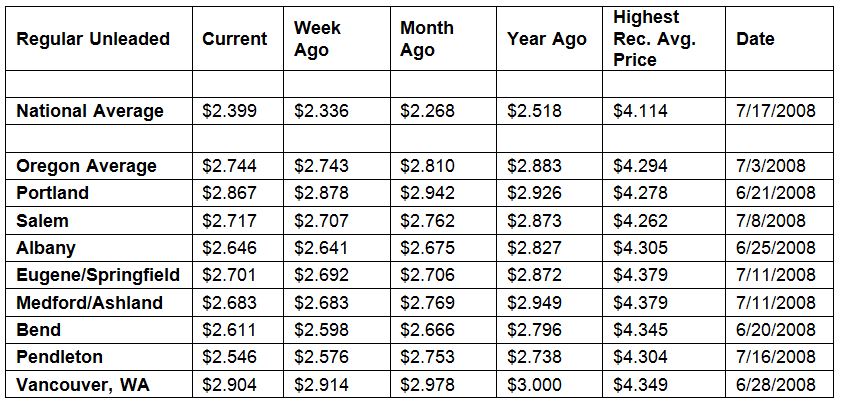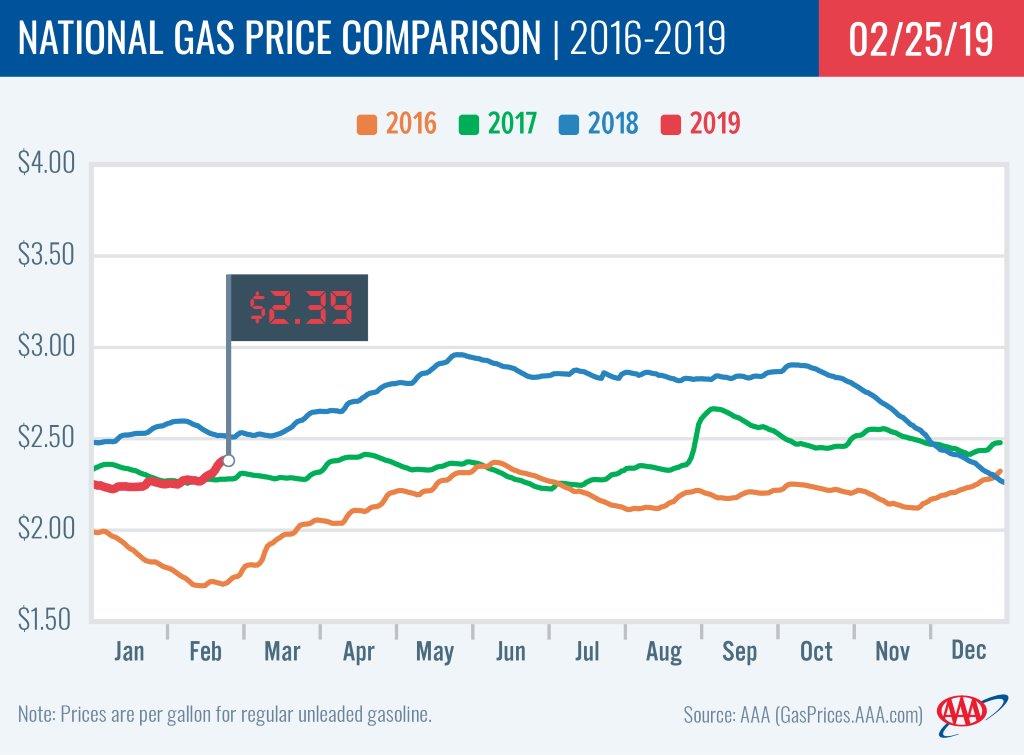Oregon and Arizona are the only states where prices are flat week-over-week
PORTLAND, Ore., – Retail gas prices are rising in most states but not Oregon as refineries gear up for spring gasoline production and maintenance season. For the week, the national average jumps six cents to $2.40 a gallon. The Oregon average remains at $2.74. The Oregon average is at its lowest price since May 2017.
Even with the increases, gas prices are on average 11 percent cheaper than the first two months of 2018, due in part to mostly cheaper crude oil prices so far this year. Drivers can fill up for $2.50 or less at about 80 percent of gas stations across the country.
Oregon and Arizona are the only two states where gas prices are flat week-over-week. 41 states and the District of Columbia have seen pump prices climb with seven states showing double-digit increases. New Mexico (+13 cents) and Florida (+13 cents) have the largest weekly increases. Alaska (-3 cents) and Michigan (-2 cents) have the largest weekly decreases. This week two states, Hawaii and California, have averages at or above $3 a gallon, same as a week ago.
Oregon is one of 11 states with lower prices now than a month ago. The national average is 13 cents more and the Oregon average is seven cents less than a month ago. Utah (-20 cents) has the largest monthly decrease. Wisconsin (+29 cents) and Illinois (+28 cents) have the largest month-over-month increases.
The West Coast continues to have some of the most expensive gas prices in the nation with most of the region’s states landing on the top 10 most expensive list. Hawaii is most expensive, followed by California, Washington, Nevada, Alaska and Oregon rounding out the top six. Oregon is sixth most expensive for the eighth week in a row.
| Rank | Region | Price on 2/26/19 | |
| 1 | Hawaii | $3.29 | |
| 2 | California | $3.28 | |
| 3 | Washington | $2.86 | |
| 4 | Nevada | $2.84 | |
| 5 | Alaska | $2.79 | |
| 6 | Oregon | $2.74 | |
| 7 | Pennsylvania | $2.63 | |
| 8 | District of Columbia | $2.57 | |
| 9 | New York | $2.53 | |
| 10 | Connecticut | $2.50 |
Prices in the West Coast region have mostly declined on the week, with Alaska (-3 cents) seeing the largest drop.
EIA’s recent weekly report shows that West Coast gasoline stocks are on the rise. They increased by approximately 700,000 bbl to 32.8 million bbl. However, stocks are approximately 1.4 million bbl lower than at this time last year, which could cause prices to spike if there is a supply challenge in the region this week.
The nation’s cheapest markets are Mississippi ($2.12) and Missouri ($2.14). For the second week in a row, no states have an average below $2 a gallon.
Oregon is one of 47 states and the District of Columbia where drivers are paying less than a year ago to fill up. The national average is 12 cents less and the Oregon average is 14 cents less than a year ago. Montana (-31 cents) has the greatest year-over-year decrease; Nevada (+5 cents), Arizona (+4 cents) and Ohio (+3 cents) are the only states with year-over-year increases.
Oil Market Dynamics
Oil prices ended last week at a new high for crude prices this year. If crude prices sustain at these higher levels, they could help send pump prices higher this spring. An increase in crude prices this week will likely be supported by optimism that the U.S. and China have been making significant strides to reduce trade tensions between the countries. However, crude price gains could be tempered by further increases in U.S. production, potentially signaling that the global crude market may be able to overcome an expected tightening in supply due to U.S-imposed sanctions on crude exports from Venezuela and Iran.
In EIA’s latest petroleum status report, the federal agency revealed that total domestic crude production hit 12 million b/d. This rate is the highest weekly estimate ever recorded by EIA, since it began tracking the data in 1983. Recent growth in domestic crude production helped to push up total domestic crude inventories by 3.7 million bbl to 454.5 million bbl last week.
In related news, Baker Hughes Inc. reported that the U.S. lost four oilrigs last week, bringing the total to 854. When compared to last year at this time, there are 54 more rigs this year.
At the close of Friday’s formal trading session on the NYMEX, WTI increased 30 cents to settle at $57.26 – setting a new high for crude prices this year. At the close of Monday’s formal trading session on the NYMEX, WTI fell $1.78 cents to settle at $55.48. Today crude is trading around $56, same as a week ago. Crude prices are up about seven percent in the last month and are about $8 per barrel lower than a year ago.
Drivers can find current gas prices along their route with the free AAA Mobile app for iPhone, iPad and Android. The app can also be used to map a route, find discounts, book a hotel and access AAA roadside assistance. Learn more at AAA.com/mobile.
Diesel
For the week, the national average adds two cents to $2.94 a gallon. Oregon’s average slips a penny to $3.04. A year ago the national average for diesel was $2.97 and the Oregon average was $3.07.
Find current fuel prices at GasPrices.AAA.com.
AAA news releases, high resolution images, broadcast-quality video, fact sheets and podcasts are available on the AAA NewsRoom at NewsRoom.AAA.com.



